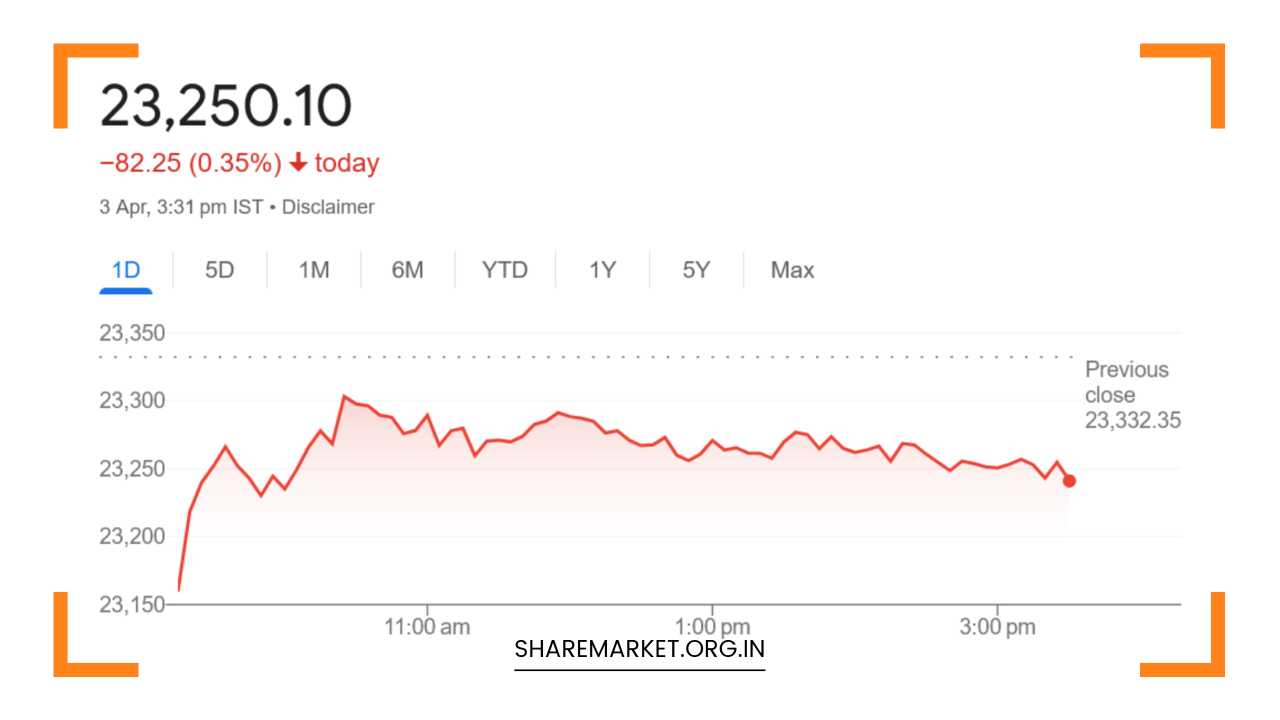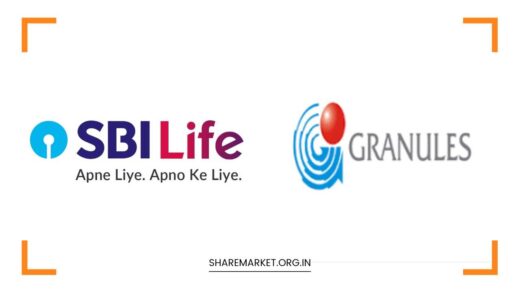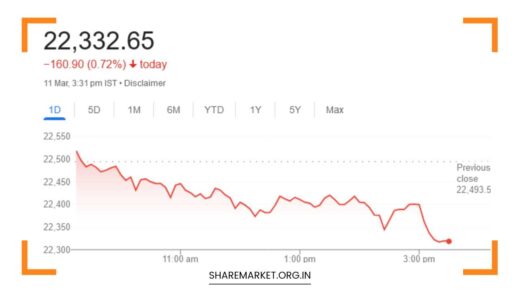Sensex Down 322 Points, Nifty at 23,250; Tomorrow Nifty Prediction

Tomorrow Nifty Prediction
Market Resilient in the Face of Trump Tariffs: What to Expect on April 4
The Indian stock market exhibited resilience on April 3, despite facing headwinds following US President Donald Trump’s announcement of new tariffs on imports from India.
While the tariff news initially triggered selling pressures, particularly in the IT and auto sectors, there was a mixed performance across sectors, with some pockets of the market showing strength, especially in pharmaceuticals.
As the market navigated through these global uncertainties, investors remained cautious but optimistic about India’s economic prospects. Looking ahead, there are crucial levels and sectoral dynamics to watch as traders prepare for April 4.
Stock Market Performance on April 3:
Indian equity indices ended lower on April 3 after the announcement of new tariffs by the US. The broader Nifty index closed at 23,250.10, down 82.25 points, or 0.35%, while the Sensex finished at 76,295.36, losing 322.08 points, or 0.42%.
The broader market, however, exhibited a mixed picture, with 2,724 stocks advancing, 1,119 stocks declining, and 132 stocks remaining unchanged.
Although the major indices ended in the red, the market breadth was relatively positive, indicating underlying strength in certain sectors.
The sell-off was particularly pronounced in the IT and auto sectors, which bore the brunt of fears about a potential slowdown in the global economy, especially in the US.
Companies in these sectors are heavily dependent on international markets, and any disruption in trade relationships, such as tariffs, can significantly impact their profitability.
On the other hand, stocks in the pharmaceutical sector gained ground, buoyed by the exemption of certain pharmaceutical products from the new US tariffs.
This development gave investors a glimmer of hope that some segments of the market could weather the storm better than others.
Among the top losers on the Nifty were large-cap IT stocks, such as TCS, HCL Technologies, Tech Mahindra, Infosys, and ONGC. Conversely, Power Grid Corporation, Sun Pharma, UltraTech Cement, Cipla, and Shriram Finance were the top gainers on the day.
Sectoral Performance:
IT Sector:
The IT sector took a significant hit on April 3, with the Nifty IT index falling by 4%. The primary reason behind the sharp decline was the renewed uncertainty surrounding the global economy, particularly in the US.
The fear of a recession and the potential disruption of global supply chains due to higher tariffs weighed heavily on investor sentiment.
Given the high dependence of Indian IT companies on the US and European markets, any signs of an economic slowdown in these regions could lead to reduced demand for services, resulting in lower revenue growth.
Auto Sector:
The auto sector was also under pressure, with the Nifty Auto index falling by 1%. A combination of fears about a US recession, ongoing supply chain disruptions, and higher input costs due to tariffs led to a cautious outlook for the sector.
Automakers, especially those who rely heavily on exports or imports of components, are particularly vulnerable to changes in trade policies.
With US tariffs adding to the already existing challenges in the domestic auto market, the sector faced significant headwinds.
Pharmaceutical Sector:
In stark contrast to the IT and auto sectors, the pharmaceutical industry saw strong performance, with the Nifty Pharma index rising by 2%.
This was primarily due to the exemption granted to certain pharmaceutical products from the new US tariffs.
India is one of the largest suppliers of generic drugs to the US, and any tariff exemptions for pharmaceutical imports were seen as a positive development for the sector.
Additionally, the growing global demand for affordable healthcare, especially in the wake of the pandemic, has continued to support Indian pharma companies, which are well-positioned to capitalize on these trends.
PSU Banks and Power Sectors:
The PSU bank index rose by 1.9%, reflecting strength in public sector banking stocks, which have gained traction due to improving asset quality and increasing credit growth.
The power sector also showed resilience, with the Nifty Power index rising by 1.8%. This was partly driven by gains in select power utilities and infrastructure stocks, which continue to benefit from the government’s push toward renewable energy and infrastructure development.
Market Sentiment:
Despite the overall decline, the market displayed resilience, driven by the strength of certain sectors and stock-specific opportunities.
Ajit Mishra from Religare Broking observed that the Nifty index showed a modest decline after the US tariff announcement but managed to recover towards the end of the session due to the strength in heavyweight stocks. This helped limit the early losses, and the index ultimately closed at 23,250.10.
Mishra also highlighted that the broader market, particularly midcap and small-cap stocks, showed strength throughout the day.
While the Nifty and Sensex indices closed lower, both the BSE Midcap and Smallcap indices ended higher, indicating a continued preference for smaller and mid-sized companies that are expected to be less vulnerable to global trade disruptions.
Impact of US Tariffs and India’s Economic Outlook:
The US tariff announcement created an air of uncertainty, but the market’s measured response indicates that investors are weighing the broader impact of the tariffs.
As Mishra noted, there is an ongoing trade negotiation between India and the US, and while the tariffs could cause short-term disruptions, they may not significantly harm India’s long-term export prospects.
Higher tariffs on other countries, particularly China, could reduce the adverse impact on Indian exports, making India more competitive in some markets.
Additionally, despite the short-term challenges posed by the tariffs, India’s macroeconomic fundamentals remain strong.
The country’s GDP growth continues to be relatively robust, and low crude oil prices are providing relief to both consumers and businesses.
Furthermore, India’s growing domestic demand and ongoing reforms in sectors like banking, infrastructure, and manufacturing are expected to provide a cushion against global headwinds.
Technical Outlook for April 4:
From a technical standpoint, traders should closely monitor the 20-day Exponential Moving Average (DEMA) at 23,100 on the Nifty index.
If the index moves below this critical support level, it could trigger further selling pressure, with the next support around the 22,800 mark.
However, as long as the Nifty remains above 23,100, the market could continue to consolidate within a defined range.
Given the mixed performance across sectors, investors are likely to focus on stock-specific opportunities.
The resilience in midcap and small-cap stocks, particularly in sectors like pharmaceuticals, PSU banks, and infrastructure, could continue to drive performance in the short term.
Final Remarks:
While the US tariff announcement has injected some volatility into global markets, the Indian stock market has shown a degree of resilience.
The market’s overall decline was mitigated by strong performances in select sectors, particularly pharmaceuticals and public sector banks.
With a focus on domestic economic strength and sector-specific opportunities, Indian investors may find reasons to remain optimistic, even in the face of external challenges.
Looking ahead to April 4, the market’s performance will largely depend on the global macroeconomic outlook, the trajectory of the US-China trade relationship, and any further developments in India-US trade negotiations.
Traders and investors should remain vigilant, focusing on key support levels, sectoral trends, and individual stock opportunities while keeping a close eye on broader economic indicators.

















